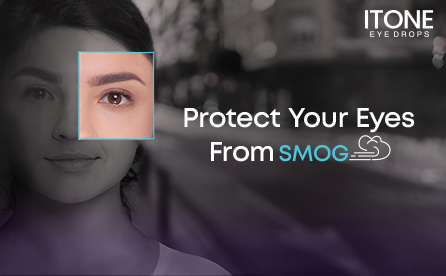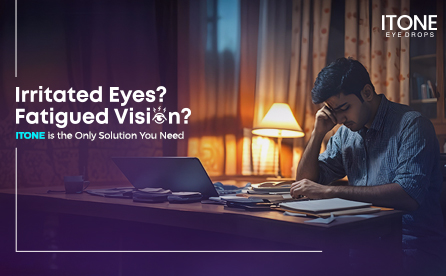
Protect Your Eyes from SMOG: Tips for Reducing Eye Irritation
Toxic smog levels are increasingly reported in India and neighbouring regions. Experts argue that the air we all breathe is poisoned by harmful pollutants and hazardous gases. Some studies on pollution claim that the air quality of India is equivalent to smoking forty cigarettes a day.
The main emitters contributing to the smog rise are vehicle exhaust emissions, industrial waste, and open burnings of agricultural refuse, which emit dangerous pollutants in the air. In 2017, the government declared it a hazard to health after achieving emergency levels.
The impact of smog falls mostly upon those who engage in outdoor play or work, such as children, and adversely affects nearly every aspect of their body. Although specialised face masks can offer a level of protection against respiratory and cardiovascular diseases, the hazardous chemicals continuously interact with the eyes. To mitigate these impacts on the eyes, opt for Itone herbal eye drops. Itone eye drops have several benefits that help you protect your sight from the smog effect.
What is SMOG?
Smog forms when smoke from factories and vehicles mixes with sunlight, creating a dense mixture of air pollutants that includes smoke, dust, ground-level ozone, and toxic chemicals. Its prevalence is very high in urban and industrial climates during conditions like winter. While everyone is well aware of the risks of smog for respiratory health, its horrific visions of destroying the eyes cannot be ignored and overlooked.
Irritating effects of smog may include redness, itchiness, and dryness of the eyes. Long-term exposure to polluted air causes allergies and damage to the cornea. Even quite small particles of the pollutant are enough to settle on the tear film covering the cornea, creating disturbance and discomfort along with disturbed vision.
So, it is essential to understand how smog affects your eyes and how to protect them with Itone ayurvedic eye drops to maintain good eye health.
How Does SMOG Affect Eye Health?
Beyond just causing short-term irritation, smog poses serious risks to eye health. Dryness and irritation can result from smog’s fine particles and chemical compounds dissolving the tears’ natural protective layer.
These particles can cause oxidative stress over time, which can worsen pre-existing conditions like dry eye syndrome and even hasten the aging process of the eyes. For those who live in highly polluted areas, prolonged exposure to smog can harm the corneal surface and impair vision.
The following are the most prevalent eye disorders brought on by smog:
- Watery eyes
- Burning sensation or discomfort
- Sore eyes
- Redness
- Swelling
- Itching sensation
- Dryness
- Eye allergies
How to Reduce Eye Irritation During the Winter?
These tips can reduce the risk of infections and lessen the irritation. Let’s know what these are:
- The best thing to do is avoid exposure to harmful pollutants. Avoid going outside as much as possible when public health warnings are issued for high levels of pollution, especially in the early morning when levels are most likely at their highest. Wearing protective eyewear should help decrease your exposure to the pollutants that are causing pollution if you have to go out when you can’t stay indoors.
- Avoid touching your eyes and wash your hands frequently after being outside to remove smog particles. This simple practice will keep pollutants from lingering near your eyes and causing irritation.
- Drink plenty of water because it will aid in the production of your tears. It becomes crucial when environmental factors, such as smog, increase your risk of developing dry eyes and eye irritation.
- Avoid rubbing your eyes. Rubbing your eyes may exacerbate irritation caused by smog particles that have settled around them. If you experience discomfort, rinse your eyes with clean water instead.
- Use Day’s Itone eye drops to hydrate your eyes; these are easily obtained at your nearest store. Neem, tulsi, sweet Chandan, and numerous other herbal ingredients keep your eyes hydrated and moisturised throughout the winter. Itone eye drops are formulated with several ingredients that benefit your eyesight.
- If the irritation continues, you must see your ophthalmologist for a check-up. To address the problems affecting your eyes, they will select a possible course of treatment.
Protect Your Vision with Smart Eye Care Practice
Smog can have serious effects on your eyes, causing dryness, redness, irritation, and even long-term damage if not addressed. Smog’s microscopic particles can interfere with the natural moisture balance of your eyes and raise your risk of allergic reactions or infections. Simple measures like applying Itone herbal eye drops and maintaining proper eye hygiene can help you safeguard your eyes.
Limiting outdoor activities during periods of high smog and using purifiers to maintain clean indoor air are further ways to reduce exposure. Keeping hydrated with Itone ayurvedic eye drops and blinking frequently also contributes to comfort and moisture retention.
The ingredients in Itone eye drops are carefully chosen to offer the best possible protection and calming effects for your eyes from environmental pollutants and smog. For optimum health and vision, make sure you follow a regular eye care regimen.
FAQs
Q. What is smog eye irritation?
The negative effect of these effluents on eye health is called “smog eye irritation.” It is established when airborne pollutants such as particulate matter, ozone, and many chemicals irritate the eyes.
Q. What are some treatments for smog eye irritation?
People who sustain smog-induced eye irritation can relieve the discomfort by wearing protective eyewear while outdoors, rinsing their eyes with clean water, and placing Day’s Itone eye drops to bring relief to dryness. Cold compresses, use of air purifiers, and seeking refuge indoors when smog is high could assuage irritation and reduce symptoms.
Q. What are the long-term effects of smog on eye health?
Chronic eye issues arise from smog exposure for a more extended period than irritation. The cumulative pollutant effect causes a drying up of the tear film and, in turn, exposes individuals to infections and other issues such as corneal damage.







